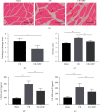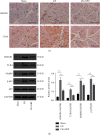Dl-3-n-Butylphthalide (NBP) Mitigates Muscular Injury Induced by Limb Ischemia/Reperfusion in Mice through the HMGB1/TLR4/NF- κ B Pathway
- PMID: 36199552
- PMCID: PMC9529425
- DOI: 10.1155/2022/5556067
Dl-3-n-Butylphthalide (NBP) Mitigates Muscular Injury Induced by Limb Ischemia/Reperfusion in Mice through the HMGB1/TLR4/NF- κ B Pathway
Abstract
Objective: Limb ischemia/reperfusion (I/R) injury is a clinical syndrome associated with severe damages to skeletal muscles and other fatal outcomes. Oxidative stress and inflammatory response play vital roles in the development of limb I/R injury. Existing evidence further indicates that Dl-3-n-butylphthalide (NBP) has anti-inflammatory and antioxidative properties. However, whether NBP can protect skeletal muscles from limb I/R injury and the mechanism in mediating the action of NBP treatment still remain to be investigated, which are the focuses of the current study.
Methods: The model of limb I/R injury was established and H&E staining was adopted to assess the pathological changes in skeletal muscles following limb I/R injury. Additionally, the W/D ratio of muscle tissue was also measured. ELISA and biochemical tests were carried out to measure the levels of inflammatory cytokines and oxidative stress in mouse models of limb I/R injury. Moreover, the levels of the HMGB1/TLR4/NF-κB pathway-related proteins were also determined using immunohistochemistry and immunoblotting.
Results: It was established that NBP treatment alleviated I/R-induced pathological changes in muscular tissue of mice, accompanied by lower W/D ratio of skeletal muscular tissue. Meanwhile, the limb I/R-induced inflammation and oxidative stress in skeletal muscles of mice were also inhibited by NBP. Mechanistic study indicated that the alleviatory effect of NBP was ascribed to inactivation of the HMGB1/TLR4/NF-κB pathway.
Conclusions: Our findings highlighted the potential of NBP as a novel strategy for limb I/R-driven muscle tissue damages by suppressing inflammatory response and oxidative stress via the HMGB1/TLR4/NF-κB pathway.
Copyright © 2022 Huanhuan Sun et al.
Conflict of interest statement
The authors declare that they have no conflicts of interest..
Figures





Similar articles
-
N-butylphthalide (NBP) ameliorated ischemia/reperfusion-induced skeletal muscle injury in male mice via activating Sirt1/Nrf2 signaling pathway.Physiol Rep. 2024 Dec;12(23):e70149. doi: 10.14814/phy2.70149. Physiol Rep. 2024. PMID: 39614673 Free PMC article.
-
N-Butylphthalide (NBP) ameliorated cerebral ischemia reperfusion-induced brain injury via HGF-regulated TLR4/NF-κB signaling pathway.Biomed Pharmacother. 2016 Oct;83:658-666. doi: 10.1016/j.biopha.2016.07.040. Epub 2016 Jul 26. Biomed Pharmacother. 2016. PMID: 27468961
-
Dl-3-n-butylphthalide pretreatment attenuates renal ischemia/reperfusion injury.Biochem Biophys Res Commun. 2021 Jun 11;557:166-173. doi: 10.1016/j.bbrc.2021.04.006. Epub 2021 Apr 14. Biochem Biophys Res Commun. 2021. PMID: 33865225
-
Dl-3-n-butylphthalide attenuates myocardial ischemia reperfusion injury by suppressing oxidative stress and regulating cardiac mitophagy via the PINK1/Parkin pathway in rats.J Thorac Dis. 2022 May;14(5):1651-1662. doi: 10.21037/jtd-22-585. J Thorac Dis. 2022. PMID: 35693588 Free PMC article.
-
Salvianolic Acid D Alleviates Cerebral Ischemia-Reperfusion Injury by Suppressing the Cytoplasmic Translocation and Release of HMGB1-Triggered NF-κB Activation to Inhibit Inflammatory Response.Mediators Inflamm. 2020 Jan 22;2020:9049614. doi: 10.1155/2020/9049614. eCollection 2020. Mediators Inflamm. 2020. PMID: 32410871 Free PMC article.
Cited by
-
Butylphthalide improves brain damage induced by renal ischemia-reperfusion injury rats through Nrf2/HO-1 and NOD2/MAPK/NF-κB pathways.Ren Fail. 2023;45(2):2259234. doi: 10.1080/0886022X.2023.2259234. Epub 2023 Sep 21. Ren Fail. 2023. PMID: 37732403 Free PMC article.
-
N-butylphthalide (NBP) ameliorated ischemia/reperfusion-induced skeletal muscle injury in male mice via activating Sirt1/Nrf2 signaling pathway.Physiol Rep. 2024 Dec;12(23):e70149. doi: 10.14814/phy2.70149. Physiol Rep. 2024. PMID: 39614673 Free PMC article.
-
Taohong Siwu Decoction Combined With the LncRNA H19/miR-675-5p Axis Repairs Limb Ischemia-Reperfusion Injury Through the Regulation of the Wnt3a/Ca2+ Signaling Pathway.Mediators Inflamm. 2025 Feb 23;2025:3096848. doi: 10.1155/mi/3096848. eCollection 2025. Mediators Inflamm. 2025. PMID: 40034562 Free PMC article.
References
-
- Rahman M. M., Halade GV., Bhattacharya A., Fernandes G. The fat-1 transgene in mice increases antioxidant potential, reduces pro-inflammatory cytokine levels, and enhances PPAR-gamma and SIRT-1 expression on a calorie restricted diet. Oxidative Medicine and Cellular Longevity . 2009;2(5):307–316. doi: 10.4161/oxim.2.5.9579. - DOI - PMC - PubMed
LinkOut - more resources
Full Text Sources

